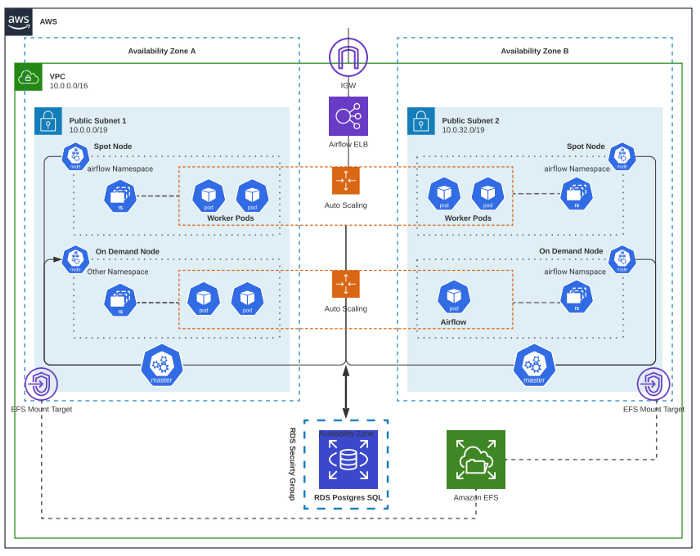Hello Readers,
I am Kunal Shah, AWS Certified Solutions Architect, Cloud Enabler by choice, helping clients to build and achieve optimal solutions on the cloud with hands on experience of 7+ Years in the IT industry.
I love to talk about #aws, DevOps, aws solution design, #cloud Technology, Digital Transformation, Analytics, Operational efficiency, Cost Optimization, AWS Cloud Networking & Security.
You can reach out to me @ www.linkedin.com/in/kunal-shah07
This is my first blog! Finally Woohoo…!! {excited :P}
let's get started with deploying AIRFLOW ON AWS EKS smoothly.
“Running Airflow on Amazon EKS with EC2 OnDemand & Spot Instances”
AIRFLOW - Airflow is a platform to programmatically author, schedule, and monitor workflows. Airflow is a platform that lets you build and run workflows. A workflow is represented as a DAG (a Directed Acyclic Graph) and contains individual pieces of work called Tasks, arranged with dependencies.
Features –
- Scalable, Dynamic, Extensible, Elegant, Easy to use.
Core Components –
- Scheduler, Executor, DAG, Webserver, Metadata Database
The best part of Airflow is it's an Open-Source Tool.
EKS - Amazon Elastic Kubernetes Service (Amazon EKS) is a managed service that you can use to run Kubernetes on AWS without needing to install, operate, and maintain your own Kubernetes control plane or nodes.
- Kubernetes is an open-source system for automating the deployment, scaling, and management of containerized applications.
ARCHITECTURE :
PREREQUISITE -
Your local machine with git bash/cmd OR Amazon Linux EC2.
I am going with T2.MICRO Amazon EC2 Instance ( Free Tier Eligible ) “tried & tested”
AWS EC2 Instance (Bastion Host) for deploying the AWS EKS cluster & communicating with the EKS cluster using kubectl.
Once EC2 is deployed we will install below mentioned dependent packages on it :
- AWS CLI version 2 — docs.aws.amazon.com/cli/latest/userguide/getting-started-install.html
- eksctl — https://docs.aws.amazon.com/eks/latest/userguide/eksctl.html#installing-eksctl
- kubectl — https://docs.aws.amazon.com/eks/latest/userguide/install-kubectl.html
- Docker — https://docs.aws.amazon.com/AmazonECS/latest/developerguide/docker-basics.html
- Helm — https://www.eksworkshop.com/beginner/060_helm/helm_intro/install/
- git — yum install git
IMP: Get your Access Key & Secret Key generated & configured on AWS EC2.
- We need to add some env variables according to the environment -
- Let’s start by setting a few environment variables:
AOK_AWS_REGION=us-east-1 #<-- Change this to match your region
AOK_ACCOUNT_ID=$(aws sts get-caller-identity --query 'Account' --output text)
AOK_EKS_CLUSTER_NAME=Airflow-on-Kubernetes
- Now we have to deploy the AWS EKS cluster using eksctl command-line utility.
- Download / Clone repo on Amazon EC2 Linux:
github.com/Kunal-Shah107/AIRFLOW-ON-AWS-EKS
{REPO with all necessary notes for this demo/poc}
- Now run the below command on Amazon Linux EC2:
eksctl create cluster -f ekscluster.yaml
(Note — ekscluster.yaml is the file in which we define the parameters of NodeGroups & Instance Types)
This will create SG, EKS Cluster (ControlPlane), Node Groups, Instance Roles.
Once the cluster is deployed through eksctl.
In the background it creates 3 cloud formation templates to deploy resources-
- EKS Cluster
- OnDemand NodeGroup
- SpotNodeGroup
Be kind as it will take 15–20 mins to set up the entire cluster Infra.
- we can now cross-check the nodes, services running in the cluster from AWS console & CLI.
kubectl get nodes
kubectl get pods -n airflow { airflow is your namespace }
kubectl get nodes — label-columns=lifecycle — selector=lifecycle=Ec2Spot
kubectl get nodes — label-columns=lifecycle — selector=lifecycle=OnDemand
- AWS EKS Cluster will be publicly accessible.
- This cluster will have two managed node groups:
- On-Demand node group that will run the pods for Airflow web-UI and scheduler.
- Spot-backed node group to run workflow tasks.
- Then we have to set up AWS infra through the git repo provided by AWS ( clone & execute ).
- We have to change the parameters as per our requirements.
git clone https://github.com/aws-samples/airflow-for-amazon-eks-blog.git
{This repo has all folders & parameters for airflow on eks setup}
cd airflow-for-amazon-eks-blog/scripts
. ./setup_infra.sh
From the setup infra, we get the following infra deployed:
PostgreSQL DB, Auto-Scaling Group, IAM role, IAM Policies, EFS, Access Points, EIP, EC2s & SGs.
Now start docker services & then we will have to use this Docker Image to create pods in Node Groups.
> service docker start
Build and push the Airflow container image to the ECR repository that we created earlier as part of the environment setup:
aws ecr get-login-password \ — region $AOK_AWS_REGION | \ docker login \ — username AWS \ — password-stdin \ $AOK_AIRFLOW_REPOSITORY
docker build -t $AOK_AIRFLOW_REPOSITORY .
docker push ${AOK_AIRFLOW_REPOSITORY}:latest
- Once the docker image is pushed to AWS ECR we can now deploy the pods.
cd ../kube {change the directory to kube}
./deploy.sh {execute the deploy.sh}
-
The script will create the following Kubernetes resources:
- Namespace: airflow
- Secret: airflow-secrets
- ConfigMap: airflow-configmap
- Deployment: airflow
- Service: airflow
- Storage class: airflow-sc
- Persistent volume: airflow-dags, airflow-logs
- Persistent volume claim: airflow-dags, airflow-logs
- Service account: airflow
- Role: airflow
- Role binding: airflow
The script will complete when pods are in a running state.
This script will deploy a classic load balancer which will have targets as nodes in which pods are running.
Pods are built from the Docker Image which we created above.
Airflow Walkthrough:
- Let’s login to the Airflow web UI, and trigger a sample workflow that we have included in the demo code. Obtain the DNS name of the Airflow web-server:
echo "http://$(kubectl get service airflow -n airflow \
-o jsonpath="{.status.loadBalancer.ingress[].hostname}"):8080\login"
Log into the Airflow dashboard using -
username: eksuser and password: ekspassword
Go ahead & change the password as soon as you log in.
DISCLAIMER- This DEMO/POC will incur some charges for RDS, EFS, EKS. So please make sure to clean up the environment once done.
- CLEANUP COMMANDS ARE THERE ON THE MENTIONED REPO:
https://github.com/Kunal-Shah107/AIRFLOW-ON-AWS-EKS.git
SOLUTION REFERENCE- https://aws.amazon.com/blogs/containers/running-airflow-workflow-jobs-on-amazon-eks-spot-nodes/
It's a bit technical & lengthy that too in my first blog ;)
But had fun deploying Airflow manually as it's cost-efficient, Highly scalable for a production-level run as compared to MWAA.
I am new to this platform. Please follow & shower some love so that I can contribute & learn in this journey.
THANK YOU FOR YOUR PATIENCE THROUGH ALL THIS.
> “As they say, Good things come to those who wait”











Top comments (0)